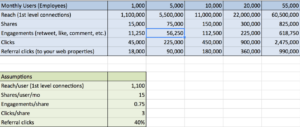Facebook Feed Changes and What It Means for Brands
No doubt you’ve heard the news: Facebook is going to be further prioritizing posts from your friends and family over posts from brands and publishers.
There’s not much to break down; it was pretty well outlined by Mark Zuckerberg in a post (I’ve embedded his complete message at the bottom of this post) and in this video produced by Facebook explaining how the feed changes will work. The net is that users will see more posts from their friends and family (other users) and less from brands, publishers, and public figures (those who post from pages).
I heard about the Facebook feed news from an acquaintance at SocialMedia.org during a chat about a presentation I’ll be giving to their membership this week on the topics of employee advocacy and social selling. We have many customers amongst their membership and they graciously asked me to spend some time talking about the future of our space. My acquaintance brought me up to speed and said that he’d spent much of the day talking with SocialMedia.org members who were concerned about the announcement.
While Facebook is and likely will remain the largest social network for some time to come, Mark Zuckerberg is clearly concerned (rightly so, IMO) that as a company they’ve strayed too far from their core, which is 100% about supporting connections and communications between friends and family.
But the current state of Facebook shouldn’t be a surprise to anyone; as the saying goes, you reap what you sow. When you (Facebook) allow anyone with a credit card to hyper-target your precious users (and there is nothing more precious than users to a social network) with commercial messages and content, the Facebook of today is what you get.
However, this isn’t/shouldn’t be about blame; in a world where you can build a social network with 889M active users in less than five years (to wit: WeChat), Facebook has to make changes like this to ensure it will remain relevant, if not the leader for the next 10+ years. I think it’s the right move for them, their users, and ultimately the brands and publishers that have made them one of the most profitable companies in the history of tech. Here’s why.
It’s time to look to your employees and community to spread your message
For going on five years now, our team and I have been of the opinion that brands should be more focused on mobilizing and leveraging their own employees to spread their message on social networks.
The reasons are patently clear (at least to us they are): the average employee has well over 1,000 connections, and we’ve seen that number consistently increase by 10% each year (gotta love compound interest in all its forms). For example, do you have a company of 5,000 employees? That means they have a network reach of 5,000,000. Have 50,000 employees? You’re looking at a network reach of 50,000,000, which as you likely know is bigger than all but the world’s largest mega-brands (e.g. Coca-Cola).
Years ago, when we first started working with brands and publishers, there were some commonly asked questions and concerns, chiefly:
- Would our people want to do this?
- What if someone posted something bad?
Thankfully I don’t think we’ve heard someone say either of those things in at least two years. However, I suspect that many social media managers and marketers privately harbor these doubts, because it’s still a relative minority who have decided to put an employee advocacy program in place at their company.
To the first question–would your people want to share company news and content with their networks–I can say the answer is unequivocally yes, and then some.
It’s not uncommon to have employees share upwards of 30 pieces of content per month. And by the way, those are employees who are in no way incentivized by their company to share that content; the incentive is that they get tools and content from their company that help them better engage and grow their network. One thing all top performing employees know: in the year 2018, if you’re not building your professional profile and network online, you’re taking yourself out of the game.
To the second question–what if something bad happened–personally, I think that’s just a bad place to start in life, but let’s roll with it. In over four years of working with some of the world’s biggest brands (Adobe, Dell, HP, Electronic Arts to name only a few) our customers have never had a single employee share something that reflected poorly on their company. Not once. How is that possible?
Well, for starters, most people want to keep their jobs; you share something bad and you’d likely be fired. Fundamentally people play by the rules because it’s about their brand and network; sharing something negative would be counterproductive to their personal and professional ambitions, which is why it doesn’t happen.
Employee shares generate clicks and engagements at 1/10th the cost of paid
When it comes to social, as a brand or publisher you’re looking for three things:
- Your content and messages to reach the right audiences
- For it to be engaged with as much and as positively as possible
- For those to things to happen for the lowest possible cost
Assuming I’m right, then it doesn’t matter if Facebook feed update completely wipes out posts from brands or publishers because achieving the above is best done by getting your own people, your own employees to share your content and messages out to their own networks.
We recently signed with a very exciting, social-forward B2C brand that wants to get all 50,000+ employees activated on their employee advocacy program by the end of 2018. This is a brand, that perhaps like yours spends hundreds of thousands of dollars per month on paid social: promoted posts, offers, etc., all primarily on Facebook.
One of the main reasons they decided to engage with us and pursue building such an ambitious employee advocacy program was they ran the numbers and found that the results they would generate from their employees’ sharing activity (clicks, engagements, re-shares) would both be larger in volume and (drum roll) cost 1/10th of what they were spending on paid. Of course, these calculations were all done before Facebook’s recent announcement, which only make the ROI of employee advocacy even stronger.
Below are some estimations we collaborated with this brand on based on a large amount of data we have from working with customers in similar markets. As described above, the scale that can be achieved with employees (not to mention the trust those employees have with their networks) is unparalleled (check out this post I wrote on the Edelman Trust Barometer). Because we wanted to present numbers that we knew we would be able to help the client hit, the inputs (shown in the green table) are quite conservative; as mentioned, it’s not atypical to see employees share upwards of 30 pieces of content per month.

If you’d like to download this spreadsheet for yourself you can grab a copy by clicking here. I’ve put some notes on a the cells to help you understand what we’re referring (e.g., Engagements/share). While I’m not a big fan of ROI calculators, I am a fan of simple math.Play around with the numbers and don’t hesitate to contact me or our team to get our opinion on if your model is achievable.
There’s never been a better time to launch an employee advocacy program
The feed changes announced by Facebook combined with advancements in employee advocacy platforms such as EveryoneSocial and the abundance of data and case studies from those that have been successful over the last five years (Dell, Electronic Arts, Kelly Services, Coupa Software) makes 2018 the perfect time to launch your own employee advocacy program.
Whereas it may have been something that primarily early adopters and top performers did in years past, this Facebook feed change is a broader trend (you likely heard of the changes Snapchat recently made to separate personal content from professional/sponsored content) that isn’t going away: as time goes on, social networks will put more and more restrictions on brands and publishers. This ia s fact. Enlisting your employees to share your company’s content is how you ensure your brand will remain front and center with your target audiences across the social spectrum for years to come.
If you need any more convincing, I suggest watching the 2 minute Facebook video again.
If you’d like to speak with myself or another member of our team about what an employee advocacy program might look like at your company, please don’t hesitate to reach out. We’d be happy to put together an estimation of the ROI we could drive for your organization based on your number of employees. We’re here to help you navigate through these changes and plot a course for even greater social media success.
Ready to turn your company workforce into a social media powerhouse and turn employees into powerful marketers, sellers, and recruiters? Schedule your personal demo of EveryoneSocial.
















